Mastering Chocolate Mousse Icing Techniques
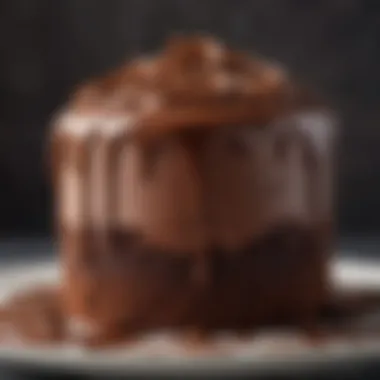

Intro
Chocolate mousse icing is not just a topping; it is an experience. Its smooth, rich texture can transform any dessert into an elegant masterpiece. This icing elevates cakes, brownies, and even pastries. It is versatile and can play well with many flavors. In this guide, we will provide a detailed exploration of techniques for creating chocolate mousse icing, making it an accessible delight for anyone, whether seasoned chef or novice.
Understanding the intricacies behind this icing allows a cook to adapt and enhance their repertoire. Anyone who seeks to save time while achieving great taste will find the information in this article invaluable.
As we move through the sections, we will look at recipes, ingredient variations, time-saving techniques, and nutritional information to better guide your culinary journeys.
Recipe Highlight
Decadent Chocolate Mousse Icing
Imagine creating a rich and creamy icing that leaves a lasting impression. This decadent chocolate mousse icing is what you'll bring to your kitchen.
Essential Ingredients
- Semisweet chocolate
- Heavy cream
- Powdered sugar
- Vanilla extract
- Salt
Preparation Time
This recipe takes approximately 15 minutes of preparation.
Servings
You can save enough icing for 12 average-sized cupcakes or one large cake.
Step-by-Step Instructions
Creating chocolate mousse icing involves several careful steps. Here’s how you can achieve that dream-like texture:
- Melt the Chocolate: Start by breaking the semisweet chocolate into pieces. Melt it in a heatproof bowl over simmering water. Ensure it does not get too hot; you simply want it melted, not cooked.
- Whip the Cream: In a seperate bowl, whip the heavy cream until soft peaks form. This means stopping before it becomes too stiff.
- Combine: Once the chocolate has cooled slightly, fold in the whipped cream gently. Use a spatula and make sure to incorporate well without deflating the cream.
- Add Sugar and Flavor: Gently incorporate the powdered sugar, vanilla extract, and salt. This will not only sweeten your icing but enhance flavor.
- Chill: For best results, let the mousse icing chill in the refrigerator for about 30 minutes before using. This will help it set more firmly.
Tips
Be careful to fold the mixture gently, as over-mixing can lead to loss of that light, airy texture crucial for mousse. Always check your chocolate; if it seizes up when melting, it will not mix well.
Variations and Substitutions
You can adapt the basic recipe for different tastes or dietary restrictions:
- Dark Chocolate: Use dark chocolate instead of semi-sweet for a richer flavor.
- Fruit Infusions: Add a purée of berries like raspberries or strawberries to create a fruity twist.
- Dairy-Free Option: Substitute heavy cream with coconut cream to produce a vegan-friendly icing.
Time-Saving Cooking Tips
Efficient cooking can make a world of difference:
- Prep Ahead: Chop chocolate into small pieces beforehand to save melting time.
- Use Tools: A whisk or electric mixer can speed up whipping cream significantly.
- Batch Cooking: Consider making mousse in larger batches and dividing it into smaller containers for future desserts.
Nutritional Information
- Light Variation for a Serving: Estimated around 150 calories per serving.
- Key Nutrients: Packed with fats and sugars; cocoa brings antioxidant properties as well.
- Diet Plan Compatibility: This mousse can be a wonderful treat in moderation for those not on rigid dietary restrictions but adjust ingredients to fine-tune allergens or health benefits.
Chocolate mousse icing not only satisfies that sweet tooth but can be crafted to fit various diets and preferences with some small tweaking.
Preface to Chocolate Mousse Icing
The art of chocolate mousse icing involves various unique techniques that unveil the nuances of designing elegant dessert toppings. Understanding this frosting component is crucial not just for aesthetics but also for flavor and texture enhancement. Chocolate mousse icing can elevate desserts, turning simple layers of cake or pastries into extraordinary creations. Its whipped texture offers a luxurious mouthfeel and exceptional taste that captivates many.
Definition and Characteristics
Chocolate mousse icing is a rich, soft blend of melted chocolate and whipped cream, thickened to the right texture that can easily spread but remains airy. Its creamy consistency is a signature trait, allowing it to smoothly glide over cake surfaces or to act as filling between layers. Made primarily from chocolate, heavy cream, and sometimes eggs or sugar, this icing strikes a balance between firmness and a light, fluffy mouthfeel.
In terms of flavor, chocolate mousse icing typically ranges from sweet to intensely chocolatey. A key characteristic lies in the type of chocolate used—whether it is dark, milk, or white chocolate, each can impart a unique flavor profile and richness to the finished product.
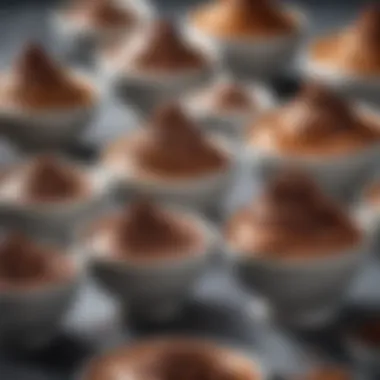
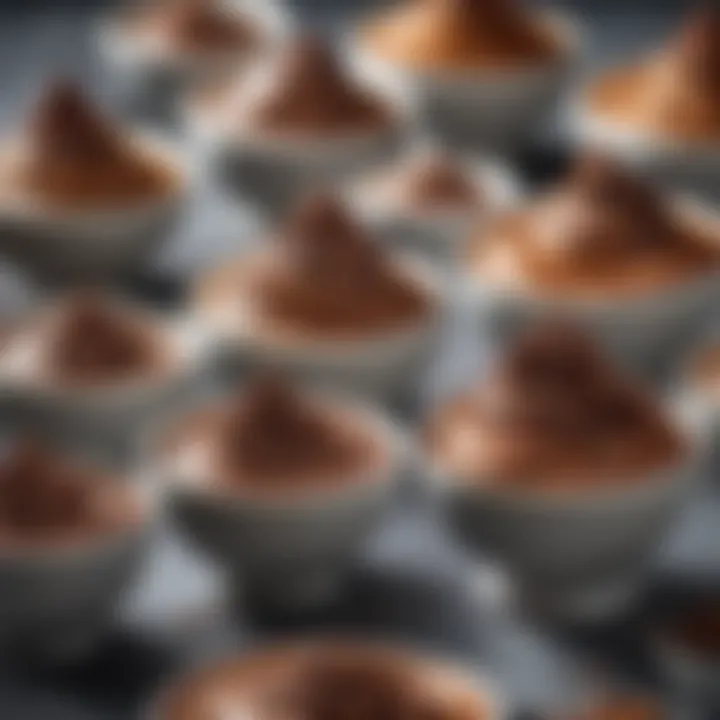
Other specific factors like temperature also play a role; properly tempered chocolate combined with well-whipped cream results in a mousse that holds its shape yet is easily removable from the spatula or spreader. Additionally, mousse icing offers versatility, able to be piped, swirled, or spread across desserts elegantly.
Popular Uses in Modern Desserts
Chocolate mousse icing is a favorite across various modern desserts, making it a versatile entry in the pastry chef's toolkit.
Here are some popular ways it is applied:
- Layered Cakes: It acts as filling and as an outer icing on multiple cake layers, providing rich contrast against lighter sponge cakes.
- Petite Fours: This icing is frequently used to coat small dessert bites, yielding a stylish finish that draws attention.
- Tarts and Pies: As a top layer for chocolate tarts, it introduces decadence while keeping a distinct visual appeal.
- Cupcakes: Swirling chocolate mousse icing on cupcakes presents a visually appealing and delicious alternative to conventional buttercreams.
- Trifles: Layers of chocolate mousse icing mixed with fruit and cake in glass containers create simple yet stunning dessert options, highlighting the mousse’s texture and flavor.
Essential Ingredients
The crafting of chocolate mousse icing is a delicate art that requires careful consideration of its essential ingredients. Each component plays a crucial role in defining the final texture, flavor, and overall quality of the icing. Focusing on high-quality ingredients ensures that the final product is truly delectable and meets the standards of discerning taste. Let’s delve deeper into the lyrical harmony of chocolate, cream, and flavor enhancements that constitute this exquisite topping.
Chocolate Types and Their Influence
The type of chocolate used in mousse icing may be one of the most pivotal decisions. Dark, milk, and white chocolates vary significantly in terms of flavor profile, sweetness, and for fully body notes. Choosing high-quality chocolate influences the viscosity and taste.
- Dark Chocolate: This type delivers a rich and slightly bitter flavor that contrasts beautifully against the sweetness. The cacao content can range, affecting the depth of flavor outcome—the higher percentages provide a more intense experience.
- Milk Chocolate: Milk chocolate yields a softer, creamier taste. It often contains more sugar, making it preferable for audiences with a sweet tooth or for applications where chocolate need not dominate.
- White Chocolate: Though technically not chocolate, it offers a luxurious texture and creamy sweetness strongly characteristic of vanilla. This ingredient can serve as a lovely base for incorporating various flavorings.
Each chocolate brings unique elements; therefore, understanding these influences enhances not just the icing but also the overall dessert experience.
Whipping Cream and Its Role
Whipping cream is another fundamental ingredient, indispensable in achieving that infamous light, fluffy texture. Its high fat content contributes critically to the mouthfeel and stabilization of the icing. Whipping cream serves dual purposes in mousse preparation: aeration and moisture retention.
By whisking cream until soft peaks form, you effectively introduce air into the mixture. This result is crucial in elevating the consistency to achieve a light fluffiness not easily attained otherwise —thus differentiating it from traditional frosting.
- Heavy Cream: Mostly recommended due to higher fat content, it promises proper aeration while providing structure.
- Modification Considerations: Some may use alternatives like coconut cream. However, adjustments in flavor should be carefully managed as not to compete with the chocolate's richness.
Without properly whipped cream, achieving desired outcomes can be unexpectedly trying. This step greatly influences the final icing texture, which supporters of the mousse admire.
Additional Flavorings and Enhancements
Adding flavorings transforms chocolate mousse icing beyond its confectionery roots, introducing tantalizing depths to its homogenous elegance. Flavor enhancers bring complexity and uniqueness.
- Vanilla Extract: A classic enhancement, it seamlessly integrates with chocolate, giving a fuller sensory experience without overtaking its chocolatey essence.
- Coffee: A dash of espresso or coffee powder elevates chocolate flavor, intensifying its characteristics while introducing a pleasing bitterness.
- Liqueurs: Brands such as Grand Marnier or Amaretto lend nuanced flavors that invite intriguing combinations. However, alternate spheres like mint, lavender, or chili may also be successful for surprise outcomes. Always handle cautiously to maintain harmony.
Properly selecting and balancing your ingredients not only enhances flavor factors but also enriches the textural quality, critical to creating standout chocolate mousse icing.
Utilizing the right set of essentials lays a formidable foundation in chocolate mousse icing preparations, inviting both delicious results and a rewarding cooking journey.
Procedure for Creating Chocolate Mousse Icing
Creating chocolate mousse icing is an essential skill for any pastry enthusiast. Understanding the specific procedures involved in making this icing provides a strong foundation. The right method ensures a smooth texture, rich flavor, and ideal appearance. As we navigate through each aspect, its benefits become clear.
Melting the Chocolate: Best Practices
Melting chocolate for mousse icing requires precision. This process lays the groundwork for both flavor and texture. Start by selecting high-quality chocolate, such as Callebaut or Valrhona. Chopping the chocolate into small, uniform pieces will allow for even melting. Using indirect heat is recommended; elements like a double boiler effectively diffuse heat and minimize burning. Alternatively, a microwave can work, but proceed in short bursts to discourage overheating. Aim for a temperature of around 45 to 50 degrees Celsius to retain the flavor profile without compromising texture.
Key points for melting chocolate:
- Chop Uniformly: Ensures even melting.
- Use Indirect Heat: Prevents burning.
- Temperature Control: Preserves flavor and texture.
Properly melted chocolate becomes a vital part of enchanting the overall mousse experience.
Incorporating Whipped Cream
The process of mixing whipped cream with melted chocolate is crucial. This step determines the lightness and volume of your icing. Use heavy cream for a rich body. Whip the cream until it reaches soft peaks to trap air, which creates a fluffy texture. Allow the melted chocolate to cool slightly before folding, as too much heat will deflate the whipped cream. Utilize a gentle folding motion; doing so preserves the airiness while just blending the two together.
Important considerations:
- Soft Peaks: Ensure cream reaches the right stage for folds.
- Temperature Alignment: Combine cream with slightly cooled chocolate.
- Folding Method: Preserve volume during incorporation.
Achieving the Right Consistency
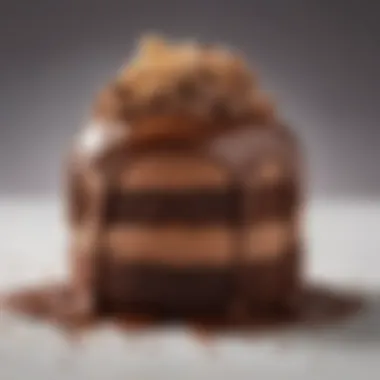

Getting the consistency just right is the hallmark of successful mousse icing. The ideal texture should neither be too stiff nor overly loose. To achieve this, utilize a test: when drizzled, the icing should hold its shape on a spatula before softly flowing. The balance between chocolate and whipped cream matters significantly here. If the mixture seems runny, consider refrigerating it for a brief period, which allows it to set slightly without ruining the texture. Conversely, if it appears too thick, you may need to gently fold in a bit more freshly whipped cream.
Consistency guide:
- Test with Spatula: Should contour pleasantly and flow slowly.
- Refrigeration Tip: Sets the icing slightly without hardening.
- Adjusting Thickness: Fold in extra whipped cream if necessary.
In mastering these techniques for creating chocolate mousse icing, one's culinary repertoire expands significantly. Understanding not just the 'how,' but the 'why' elevates one's confidence in the kitchen. This icing not just enhances desserts but imparts a touch of sophistication to contemporary sweet treats.
Variations of Chocolate Mousse Icing
Variations of chocolate mousse icing play a crucial role in expanding the versatility and appeal of this dessert topping. Each variation allows for a distinctive flavor profile and aesthetic, catering to diverse tastes and occasions. By understanding these variations, cooks can better tailor their sweet creations to suit specific dessert themes or enhance flavor experiences. Delivering a range of chocolate mousse icing types not only enriches any menu but also provides an opportunity for creativity in culinary practice.
Dark Chocolate Mousse Icing
Dark chocolate mousse icing is often favored for its rich flavor and velvety texture. Using high-quality dark chocolate elevates the overall taste, making it a perfect fit for sophisticated desserts. To create this variation, opt for chocolates containing a cacao percentage of 60% or higher.
When preparing dark chocolate mousse icing, consider the following aspects:
- Richness: The higher cocoa content lends a bitterness that balances sweetness well, making it suitable for desserts like flourless chocolate cake or cheesecakes.
- Texture: By carefully incorporating air into the mixture, the icing achieves a light and fluffy texture, which complements denser desserts.
- Appearance: The deep color of dark chocolate enhances visual appeal, contrasting beautifully with lighter cake types.
Over time, this variant has become established as a signature choice in baking, combining elegance with indulgence.
Milk Chocolate Mousse Icing
Milk chocolate mousse icing typically offers a sweeter and creamier experience than dark chocolate. The distinct flavor comes from the addition of milk solids, balancing sweetness and richness effectively. This style strikes enjoyment amongst those who prefer less bitter options.
In preparing the milk chocolate variant, one might consider:
- Sweetness Level: Due to its nature, it pairs exceptionally well with fruits such as raspberries or strawberries, which provide a refreshing contrast.
- Versatility: This icing works marvelously with layered cakes, combining well with buttercream or frosting elements to create layered richness.
- Balancing Techniques: Adjusting the cream quantity will alter the texture. A stiffer icing can be produced for decorative piping.
For celebration cakes or lighter desserts, milk chocolate mousse icing remains a widely appreciated choice.
White Chocolate Adaptations
White chocolate, while technically not categorized as chocolate due to the absence of cocoa solids, brings a unique sweet flavor that's creamy and smooth. Adapting white chocolate for mousse icing provides a different yet enticing option. This variation can sometimes be less indulgent, appealing to palates drawn to milder tastes.
For effective execution, here are a few considerations:
- Flavor Enhancements: Adding flavors like vanilla bean, lemon zest, or almond extract can elevate the white chocolate experience significantly.
- Supplementing Ingredients: Mixing with a small quantity of dark or milk chocolate can create a well-rounded icing, enhancing complexity while maintaining the essence of white chocolate.
- Color Play: This adaptation opens doors for decorative options, allowing decorations such as edible flowers or colorful sprinkles to stand out pleasingly against a light backdrop.
Overall, the diverse variations of chocolate mousse icing allow cooks and bakers to reflect personal tastes and culinary skills uniquely. Each adaptation invites various flavor sensations and aesthetic choices, contributing essential depth to dessert presentations.
Application Techniques
Understanding the application techniques for chocolate mousse icing is essential for achieving an appealing and professional dessert presentation. When considering the application methods, cooks must evaluate factors such as the consistency of the icing, tools available, and desired aesthetic outcome. Proper application can enhance the overall experience of a dessert by improving its visual appeal and texture, making it more enticing to the observer and the drawer of dessert forks alike.
Various Ways to Apply the Icing
There are multiple methods for applying chocolate mousse icing, each ideal for specific dessert types. One common method is spreading, which allows for an even coat across cakes or pastries. This technique requires an offset spatula or a straight-edged tool to attain the desired smoothness.
Another method is piping, in which the icing is transferred to a piping bag. Piping enables more intricate designs and is perfect for adding decorative touches on pastries, cupcakes, or plated desserts. Using different piping tips can create various textures, leading to a more refined presentation.
Lastly, the drizzle method plausibly creates an artistic visual. This technique suits desserts like cheesecakes or puddings. Here, melted chocolate is combined with the mousse icing to add contrasting colors, enhancing aesthetic appeal.
Techniques for Smooth Finishes
Achieving a smooth finish with chocolate mousse icing can determine a dessert’s visual success. Start with a well-prepared mousse, ensuring it is adequately aerated but stable. It should be spread or piped while still slightly chilled to prevent melting. Using an offset spatula to apply icing can smooth the surface effectively, while gently holding the tool at an angle can result in a polished look.
Additionally, a warm spatula can also assist in refining the surface. Dipping the spatula in warm water and wiping it off will reduce friction and help eliminate any imperfections, thus contributing to a professional-quality effect.
Layering and Decoration Techniques
Layering is a powerful technique to generate depth in desserts. Layering different icing colors or textures invites a visual dimension that captivates any admirer of baked goods. For instance, alternating layers of dark and white chocolate mousse icing can produce striking contrasts. You can use clear pastry rings to create these layers effectively.
To finalize decoration, consider incorporating various edible decorations such as chocolate shavings, fresh fruits, or nuts. These elements can merge with the layering, creating a unified dessert. A dusting of cocoa powder right before serving adds an elegant finish.
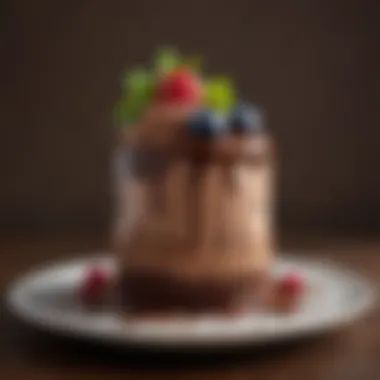
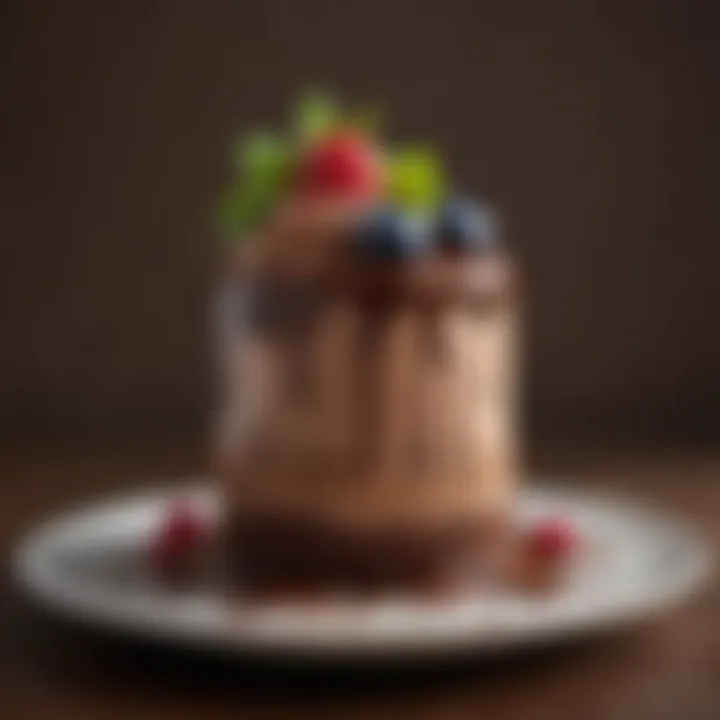
As always, versatility is key. Adapt these methods according to the frosting you prefer to either enrich your cakes or elevate your individual servings.
Mastery of icing application will not just enhance the flavor but transform the entire pastry experience altogether.
Troubleshooting Common Issues
Troubleshooting common issues is critical in mastering chocolate mousse icing. Understanding how to resolve problems can save time and ingredients. It also gives confidence when risking creativity in the kitchen. This section examines key challenges faced by cooks, enhancing their experiences with chocolate mousse icing. Readers will learn how to identify, correct, and avoid issues related to separation and consistency, leading to a refined icing quality.
Separation and Consistency Problems
One common issue with chocolate mousse icing is separation, where the mixture breaks down into components instead of remaining smooth and cohesive. This problem can occur due to several reasons, primarily related to the handling of chocolate or cream.
Key Factors To Consider:
- Temperature Control: Both the cream and melted chocolate must be at similar temperatures when combined. If one is too hot or too cold, it can lead to separation.
- Correct Emulsification: Whipping cream must be whipped adequately before being folded into chocolate. Under-whipping may not provide the structure needed for a good ensemble.
To fix this issue, gently re-emulsify by applying a consistent mixing technique with a warm water bath if in severe trouble. Avoid forceful actions which can introduce more air, further destabilizing the icing.
Incorporating Air Properly
Incorporating air into chocolate mousse icing is crucial for texture and volume. When whipped cream or egg whites are added haphazardly, the air can escape, resulting in a dense icing. Such density inhibits that desired, light quality traditional for mousse. Therefore, proper technique is paramount for ideal outcomes.
Ways to Incorporate Air Effectively:
- Fold Gently: After whipping the cream to soft peaks, use a spatula to fold the cream into the chocolate gently. Aim for a smooth, uniform mixture without deflating the air incorporated.
- Use the Right Tools: Opt for a wide bowl and offset spatula during mixing. This allows gentle movements. Avoid noisy electric mixers during the folding stage.
- Gradual Addition: When adding the whipped cream, do it gradually in portions. This method helps maintain structure without overwhelming the chocolate base.
Even minor mistakes in this area can lead to undesired texture, aptly emphasizing the value of learning multiple techniques for proper air incorporation and achieving that perfect lightness every time.
Engaging in proper techniques for troubleshooting can not only enhance your chocolate mousse icing but also build your overall expertise in dessert-making.
Storing and Serving Chocolate Mousse Icing
Storing and serving chocolate mousse icing properly is crucial to maintaining its quality and ensuring an enjoyable tasting experience. After spending time perfecting the icing, it is essential to consider how to keep it fresh until it is time to use it. Knowing how to store chocolate mousse icing can extend its lifespan and helps preserve essential texture and flavor attributes. In addition, understanding the best serving practices can enhance the overall presentation of desserts, making them more visually appealing to everyone involved, including family and friends.
Best Practices for Storing Icing
The first step in preserving chocolate mousse icing is to ensure it is cooled to room temperature before storage. Placing warm icing into the fridge can result in unwanted condensation, which can affect both texture and taste. When ready to store the icing, opt for an airtight container. Doing so is paramount to prevent the icing from absorbing any odors or flavors from the fridge, which could alter its original richness.
Consider refrigerating the icing when storing. Chocolate mousse icing typically remains fresh when kept in the refrigerator sealed in an airtight container for up to a week. However, it is important to check for any changes in smell or texture before using it again. As an added benefit, if you find yourself needing to prepare the icing in advance, freezing is also an option. In this case, transfer the mousse icing into a freezer-safe container, leaving space for expansion. When ready to use, allow the icing to thaw in the fridge for several hours or overnight. Keep in mind that the texture might change slightly; some gentle re-whipping may restore it back to a more optimal consistency.
Serving Suggestions
Enhancing your foodie creations with beautifully served chocolate mousse icing can elevate a simple dessert or pastry into something extraordinary. First, ensure the icing is at the right temperature; served too cold, it might be hard, while icing served at room temperature can spread nicely over cakes and pastries. Here are several ways to serve chocolate mousse icing to impress your guests:
- Piped Decorations: Use a piping bag with various tip sizes to create intricate designs on top of cakes or cupcakes. This adds a layer of professionalism and flair.
- Layered Desserts: Combine chocolate mousse icing within layered parfaits, using glasses to showcase the beautiful contrast between layers. Adding complementary ingredients, such as fresh berries or crushed cookies, increases flavor depth.
- On Top of Brownies: Spread icing generously over baked brownies for a delicious finishing touch. Garnishing with shaved chocolate adds an extra visual appeal.
- Complement with Fruit: Present slices of cake with a dollop of chocolate mousse icing alongside fresh fruit, such as strawberries or bananas, to balance out richness.
Carefully serving your creations not only beautifies the plate but also enhances the sensory experience of the dessert being enjoyed.
Understanding how to store and serve chocolate mousse icing effectively unlocks its quick adaptability for various desserts while keeping it substantially enticing and fresh. As a busy cook, these insights can save critical time while attracting compliments on your enticing plating skills.
End
The conclusion of this article lays out the importance of mastering chocolate mousse icing as a vital pudding to elevate your dessert creations. This rich confection, with its creamy texture and vibrant flavor, can significantly enhance the dining experience. Understanding its components, preparation methods, and potential variations is not merely an academic exercise; it is a practical skill, especially for individuals who wish to impress guests or indulge personal cravings.
Summary of Key Points
Important aspects of chocolate mousse icing included:
- Essential Ingredients: Knowledge of chocolate types and cream influences can notably affect flavor and consistency.
- Procedure for Creation: Following the accurate methods for melting chocolate and incorporating whipped cream yields impeccable results.
- Variations: From dark to white chocolate mice icing, each variation presents a unique taste and can cater for different dessert needs.
- Application Techniques: Specific methods for applying and finishing the icing secure a polished final appearance.
- Troubleshooting: Practical problem-solving for common issues ensures a more consistent outcome.
- Storage and Serving Tips: Proper practices for storing and serving maintain quality and taste until the icing is elegantly presented.
These elements collectively create a framework not only for successful application but also for innovation in the kitchen.
Encouragement for Culinary Exploration
Adventurous cooking can transform mundane baking into an avenue for personal expression. As culinary techniques evolve, engaging with chocolate mousse icing is a way to experiment with flavors and style. It may seem unhandy initially, yet with each attempt, confidence blossoms.
Consider using your unique preferences or seasonal ingredients to alter the traditional chocolate mise icing. Explore combinations like the addition of espresso for depth or using spices like cinnamon for an interesting twist. Visualizing how each ingredient interacts can spur even greater creativity. Appreciate the process as you embark on creating your new mesmerizing dessert masterpieces.
Thinking broadly, the world of chocolate mousse icing generally opens doors to numerous dessert possibilities, allowing for enhancement not merely of sweetness but of overall flavor dynamics. Uncle of flavors transcend each dish it graces.
Experimentation not only enhances the pleasure of your culinary outcomes but expands your knowledge as home chefs. So mix, whip, and enjoy the art without fear of failure. The kitchen is a place for growth and joy.







